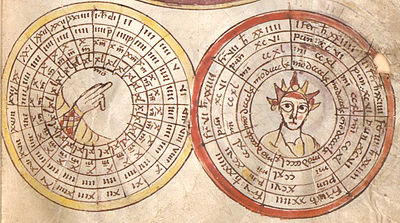
A moment (momentum) is a medieval unit of time. The movement of a shadow on a sundial covered 40 moments in a solar hour, a twelfth of the period between sunrise and sunset. The length of a solar hour depended on the length of the day, which, in turn, varied with the season. Although the length of a moment in modern seconds was therefore not fixed, on average, a medieval moment corresponded to 90 seconds. A solar day can be divided into 24 hours of either equal or unequal lengths, the former being called natural or equinoctial, and the latter artificial. The hour was divided into four puncta (quarter-hours), 10 minuta, or 40 momenta.
The unit was used by medieval computists before the introduction of the mechanical clock and the base 60 system in the late 13th century. The unit would not have been used in everyday life. For medieval commoners the main marker of the passage of time was the call to prayer at intervals throughout the day.
The earliest reference found to the moment is from the 8th century writings of the Venerable Bede, who describes the system as 1 solar hour = 4 puncta = 5 lunar puncta = 10 minuta = 15 partes = 40 momenta. Bede was referenced five centuries later by both Bartholomeus Anglicus in his early encyclopedia De Proprietatibus Rerum (On the Properties of Things), as well as Roger Bacon, by which time the moment was further subdivided into 12 ounces of 47 atoms each, although no such divisions could ever have been used in observation with equipment in use at the time.
References
- North, John David (1988). Chaucer's Universe. University of Michigan Press.
- Bede (1999). The Reckoning of Time. Liverpool University Press. p. 267. ISBN 9780853236931. Retrieved 23 January 2017.
- Bacon, Roger. Opera quaedam hactenus inedita. Oxford University Press. p. 45. Retrieved 5 July 2014.
- Bede (1999). The Reckoning of Time. Liverpool University Press. p. 268. ISBN 9780853236931. Retrieved 23 January 2017.
- Bede (1999). The Reckoning of Time. Liverpool University Press. p. 15. ISBN 9780853236931. Retrieved 23 January 2017.
- Bede (1999). The Reckoning of Time. Liverpool University Press. p. 73. ISBN 9780853236931. Retrieved 23 January 2017.
- ^ Bacon, Roger. Opera quaedam hactenus inedita. Oxford University Press. p. 48. Retrieved 5 July 2014. Note the distinction between minucia and minuta, as well as the introduction of the ostenta, the precursor to the modern minute.
- Middle English dictionary. University of Michigan Press. 1977-12-31. p. 644. ISBN 978-0472011360. Retrieved 5 July 2014.
| Time measurement and standards | ||
|---|---|---|
| International standards |
|   |
| Obsolete standards | ||
| Time in physics | ||
| Horology | ||
| Calendar | ||
| Archaeology and geology | ||
| Astronomical chronology | ||
| Other units of time | ||
| Related topics | ||
| Time | |||||||||
|---|---|---|---|---|---|---|---|---|---|
| Key concepts | |||||||||
| Measurement and standards |
| ||||||||
| Philosophy of time | |||||||||
| Human experience and use of time | |||||||||
| Time in science |
| ||||||||
| Related | |||||||||
This standards- or measurement-related article is a stub. You can help Misplaced Pages by expanding it. |
This time-related article is a stub. You can help Misplaced Pages by expanding it. |